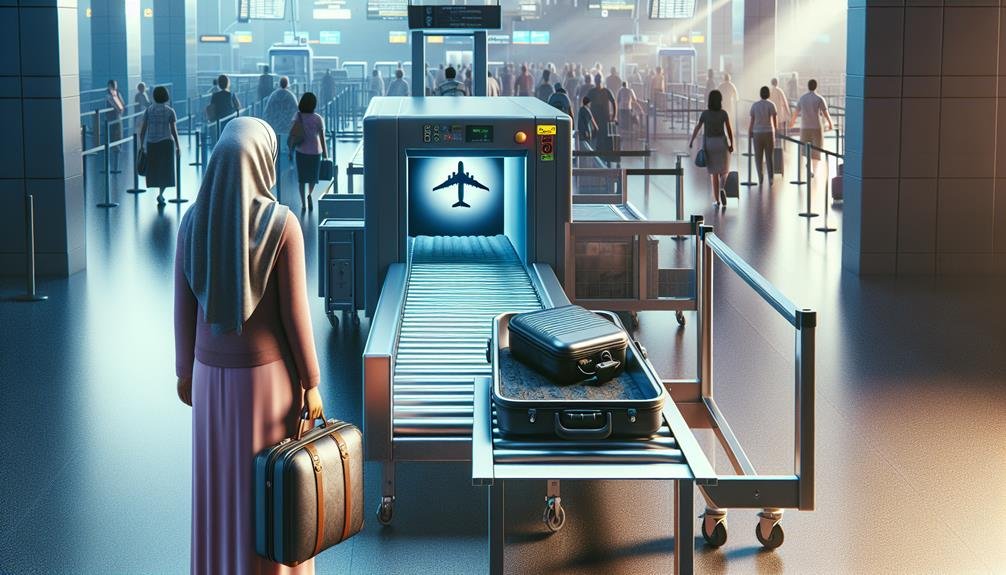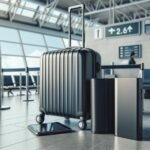You can't pack power banks in checked-in baggage due to strict safety regulations. This rule is to reduce fire risks posed by lithium-ion batteries which can overheat and cause fires. Aviation standards require you to carry power banks in your carry-on luggage instead. This guarantees that any potential issues with the battery can be managed swiftly and safely. Always keep your power bank accessible during security checks. Understanding these safety guidelines is important for a smooth travel experience and there's much more to know about packing and regulatory standards.
Airport Security Regulations

When flying, it's essential to be aware of airport security regulations that strictly prohibit packing power banks in checked-in baggage. This rule is in place to guarantee passenger safety and compliance with international aviation standards. During security screening, officers will check for any electronic devices in your luggage, and power banks are a specific point of focus.
Power banks, especially those with high battery capacity, pose particular risks during air travel due to the potential for overheating and fire hazards. As a result, authorities mandate that these devices must be carried in your carry-on luggage. This allows for immediate access and control if any issues arise during the flight. You'll need to check the battery capacity of your power bank, as those exceeding a certain watt-hour (Wh) limit may require additional approval from the airline.
Furthermore, familiarize yourself with the specific regulations of the airline you're flying with, as individual carriers may have additional restrictions or requirements. By adhering to these guidelines, you contribute to a safer flying experience for everyone on board. Remember, understanding and following airport security regulations is essential for ensuring your journey is both safe and compliant.
Reasons for Restrictions
The restrictions on placing power banks in checked-in baggage exist primarily due to the significant fire risks associated with lithium-ion batteries. These batteries can overheat, leading to thermal runaway—a chain reaction that can cause fires or explosions. Such incidents pose severe safety concerns, especially in the confined cargo hold of an aircraft. The inability to promptly address a fire in this area increases the risk to passengers and crew.
International regulations, including those from the International Civil Aviation Organization (ICAO) and the International Air Transport Association (IATA), mandate that power banks must be carried in carry-on luggage. This guarantees that any potential battery malfunction can be quickly managed by the cabin crew. These regulations aren't arbitrary; they're based on extensive research and real-world incidents that underscore the dangers of lithium-ion batteries in checked baggage.
In addition to international regulations, airlines have their own specific guidelines to comply with safety protocols. Ignoring these rules not only endangers everyone on board but can also result in fines or denied boarding. By adhering to these safety measures, you contribute to a safer flying environment for all.
Types of Power Banks

Power banks come in a variety of capacities, designs, and features, each tailored to meet specific user needs and regulatory standards. When selecting a power bank, you'll need to take into account factors such as charging capacity, size and weight, charging speed, and compatibility with your devices.
Here's a quick comparison of different types of power banks:
| Type | Charging Capacity | Size and Weight |
|---|---|---|
| Mini Power Banks | 1,000-5,000 mAh | Small, Lightweight |
| Standard Power Banks | 5,000-10,000 mAh | Moderate |
| High-Capacity Power Banks | 10,000-20,000 mAh | Larger, Heavier |
| Ultra High-Capacity Power Banks | 20,000+ mAh | Bulky, Heaviest |
| Solar Power Banks | 5,000-20,000 mAh | Varies |
Your power bank's charging speed is another crucial aspect. Fast-charging options can greatly reduce the time it takes to recharge your devices. Compatibility is equally important; make sure the power bank supports the voltage and current requirements of your gadgets.
Regulatory standards often restrict high-capacity power banks from check-in baggage due to safety concerns. Always verify that your power bank meets airline safety guidelines to avoid any issues during travel.
Packing Tips
Proper packing of your power bank is crucial to guarantee compliance with airline regulations and to safeguard your devices. When preparing for your trip, remember that power banks fall under baggage restrictions and are typically considered carry on essentials. This means you should never place them in your check-in baggage due to safety regulations.
One of the most important packing hacks is to keep your power bank in your carry-on bag. Make sure it's easily accessible for inspection at security checkpoints. Use a protective case to prevent damage and avoid any short circuits. If you're carrying multiple power banks, ensure they're individually wrapped or separated to minimize any risk.
Additionally, check the watt-hour rating of your power bank. Airlines often restrict power banks over a certain capacity. Generally, if your power bank is under 100 watt-hours, it's allowed without prior approval. For those between 100 and 160 watt-hours, you may need airline permission. Always verify the specific regulations of your airline before travel.
Lastly, consider your overall travel essentials. Pack your power bank alongside other important items like chargers and adapters, making sure everything is organized and within reach. This approach not only complies with regulations but also enhances your travel safety and convenience.
Alternative Solutions

Considering the restrictions on carrying power banks in check-in baggage, exploring alternative solutions can guarantee both compliance and convenience during your travel. One effective approach is to opt for portable chargers that meet regulatory guidelines for carry-on luggage. Most airlines permit battery packs below a certain watt-hour (Wh) rating, typically under 100 Wh, to be carried in your cabin baggage. Checking the specifications of your electronics can confirm they adhere to these limitations.
Another alternative is utilizing charging stations available at airports. Many modern airports are equipped with dedicated charging points, reducing your reliance on personal power banks. Also, if you need a reliable power source, consider renting battery packs from airport kiosks or shops. These rented units often comply with travel restrictions, offering a safe and convenient solution.
For longer journeys, you may plan to use devices with extended battery life, thereby minimizing the need for frequent recharges. Additionally, investing in high-quality, airline-compliant portable chargers can provide peace of mind. Always double-check the airline's specific policies on electronics and battery packs to avoid any disruptions. By preparing ahead, you can ensure a seamless and safe travel experience.
Frequently Asked Questions
What Happens if I Accidentally Pack a Power Bank in Checked Luggage?
If you accidentally pack a power bank in checked luggage, airline policies may require its removal due to safety concerns about potential fire hazards. Always check airline guidelines to guarantee compliance and avoid delays or penalties.
Can I Carry Multiple Power Banks in My Carry-On Bag?
Power bank restrictions permit multiple power banks in your carry-on, but airport security guidelines limit each to 100 watt-hours. Make sure they're properly packed to prevent short circuits and follow airline-specific rules for safety's sake.
Are There Size or Capacity Limits for Power Banks in Carry-On Luggage?
Yes, there are size restrictions and capacity limits for power banks in carry-on luggage. Airline policies and safety concerns dictate that power banks typically must be under 100Wh, with some exceptions requiring airline approval. Always check specific guidelines.
How Should I Declare My Power Bank at Airport Security?
Think of your power bank as a red flag for airport security. Declare it at the checkpoint by informing the officers. Confirm it meets travel regulations and follow the declaration process for safety and compliance.
What Are the Consequences of Not Following Power Bank Regulations?
Not following power bank regulations can lead to safety risks, fines, and travel restrictions. The consequences include potential flight delays and confiscation of your device, emphasizing the importance of adhering to airline safety guidelines for everyone's protection.



